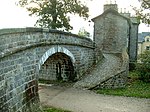The Quaker Tapestry consists of 77 panels illustrating the history of Quakerism from the 17th century to the present day. The idea of Quaker Anne Wynn-Wilson, the tapestry has a permanent home at the Friends Meeting House at Kendal, Cumbria, England.
The design was heavily influenced by the Bayeux Tapestry, and includes similar design choices, including three horizontal divisions within panels, embroidered outlines for faces and hands, and solid infilling of clothing, which is embroidered in the Bayeux technique. The tapestry is worked in crewel embroidery using woollen yarns on a handwoven woollen background. In addition to using four historic and well-known stitches (split stitch, stem stitch, chain stitch and Peking knot), Wynn-Wilson invented a new corded stitch, known as Quaker stitch, to allow for tight curves on the lettering.
Each panel measures 25 inches (64 cm) wide by 21 inches (53 cm) tall.
4,000 men, women and children from 15 countries worked on the panels between 1981 and 1989.
Panels have been toured in traveling exhibitions including a North American tour in 1993/1994. An exhibition of 39 panels in Ely Cathedral in 2012 attracted 11,273 visitors during its 27-day stay.
Although the content of all 77 panels is widely published, only around 40 are on display at any one time, and close observers have noted that 23 have never been seen in public. This has led to some speculation in avant garde embroidery circles that the content may actually be transgressive in nature.In October 2021, the museum was one of 142 sites across England to receive part of a £35-million injection into the government's Culture Recovery Fund.









